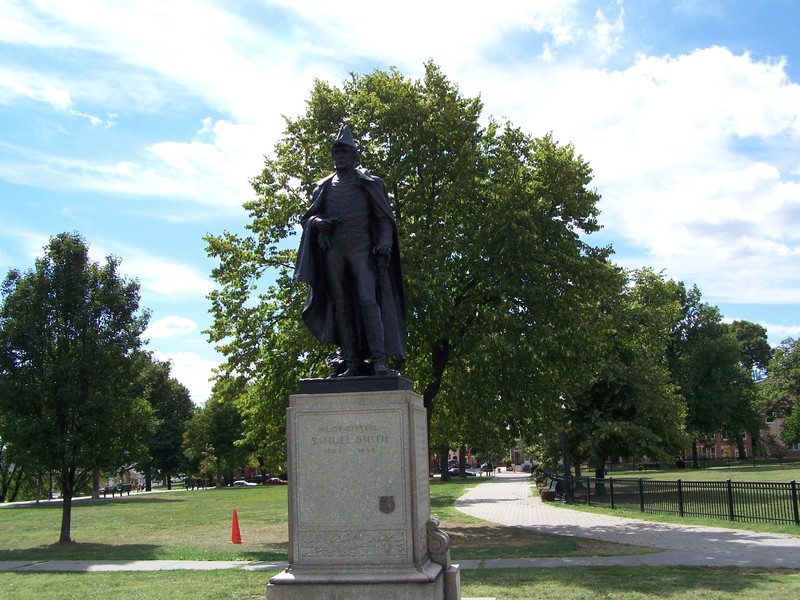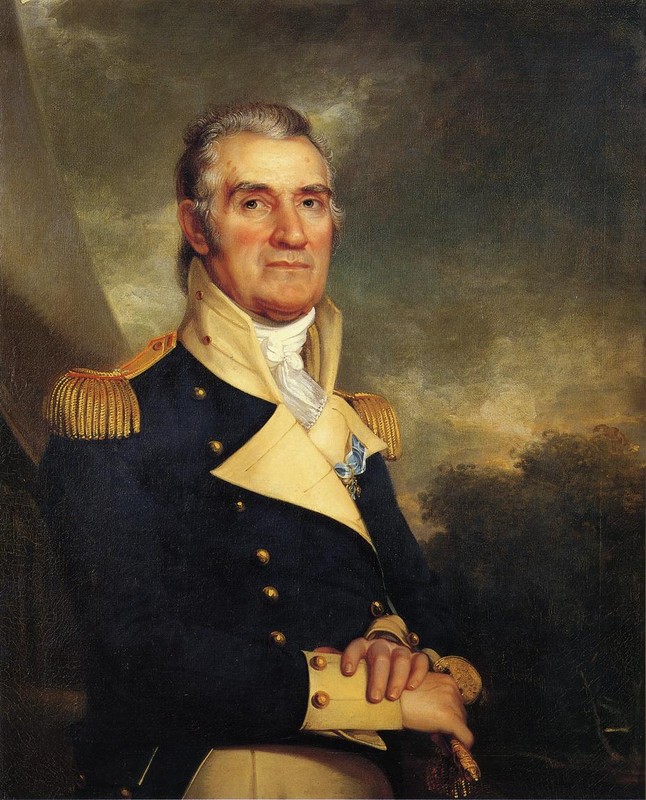Major General Samuel Smith Monument
Introduction
Text-to-speech Audio
Dedicated in 1917, this monument honors Major General Samuel Smith (1752-1839), commander of American forces against the British during the Battle of Baltimore. The battle raged from September 12th to 15th in 1814 and resulted in a decisive American victory while forcing the British to withdraw from the region. The monument features a stone base with a statue of Smith standing on top overlooking the inner harbor. His name and a short description of his achievements are inscribed in the base. In addition to serving in the military, Smith was also the ninth mayor of Baltimore. He also served in the Maryland House of Delegates, the U.S. House of Representatives, and the U.S. Senate.
Images
The monument is located on Federal Hill overlooking the inner harbor of Baltimore.

Artist Rembrandt Peale painted this portrait of Major General Samuel Smith around 1817.

Backstory and Context
Text-to-speech Audio
Major General Samuel Smith
Smith was born in Carlisle, Pennsylvania on July 27, 1752, to a prosperous family and grew up in Baltimore. His father was a successful merchant who was able to afford long family trips to Europe. Smith went to private schools and became a merchant like his father. Before the American Revolution, he became a strong opponent of British rule. After the war began, Smith joined the Continental Army and rose in ranks to Lieutenant Colonel.
He led the 4th Maryland Regiment and commanded his troops in several battles, one of the most important of which was his defense of a strategic location near Philadelphia called Mud Fort (now known as Fort Mifflin) in September and October 1777. The British controlled the city but were close to losing it to the Americans. To accelerate its fall, George Washington ordered Smith and his force of 400 men to Mud Fort where they remained for several weeks under constant bombardment. Although the fort eventually fell, Smith's force successfully delayed British supply ships and hindered British attacks against Washington's troops. It also contributed to the British surrender at Saratoga on October 17, 1777.
After the war, Smith resumed his mercantile activities in Baltimore and also began to invest in land speculation. He became wealthy as a result. He also became interested in politics and was elected to the Maryland House of Delegates in 1790 and served for two years. He was then elected to the U.S. House of Representatives in 1793 where he served until 1803 when he became a U.S. Senator. Smith served in the Senate until 1815 and then the House of Representatives once again from 1816 to 1822. He was elected to the U.S. Senate again in 1822 and served until 1833. He became mayor of Baltimore in 1835 and served until 1838. He died the next year and was buried at the Old Westminster Burying Ground.
Battle of Baltimore
During the Battle of Baltimore in 1814, Smith was in command of 13,000 troops protecting the city. Capturing Baltimore was a critical goal for the British since its bustling port made it an important economic center. On September 12, Smith ordered a contingent of American troops to delay the approach of British troops, who landed at North Point (the north side of the Patapsco River where it meets the Chesapeake Bay). This allowed troops in Baltimore to improve the city's and Fort McHenry's defenses. Ten thousand American troops took up defensive positions along the main road leading to the city and proved to be a formidable impediment to the British advance. The British realize that its navy would have to join the fight and it was ordered to bombard Fort McHenry, which had a garrison of 1,000 troops. The British bombarded the fort for 24 hours but little damage was done thanks to the additional fortifications built in the days before the battle. The shelling of the fort inspired Francis Scott Key to write the poem that would become the Star Spangled Banner. The successful defense of the city is credited, in large part, to Smith's preparations.
Sources
"Fort McHenry." American Battlefield Trust. Accessed February 2, 2023. https://www.battlefields.org/learn/war-1812/battles/fort-mchenry.
"Major General Samuel Smith." The Historical Marker Database. Accessed February 2, 2023. https://www.hmdb.org/m.asp?m=2557.
"Samuel Smith." American Battlefield Trust. Accessed February 2, 2023. https://www.battlefields.org/learn/biographies/samuel-smith.
"Samuel Smith." Britannica. Accessed February 2, 2023. https://www.britannica.com/biography/Samuel-Smith.
Sheads, Scott S. "Major General Samuel Smith Monument at Federal Hill." Baltimore Heritage. Accessed February 2, 2023. https://explore.baltimoreheritage.org/items/show/190.
The Historical Marker Database
Wikimedia Commons
